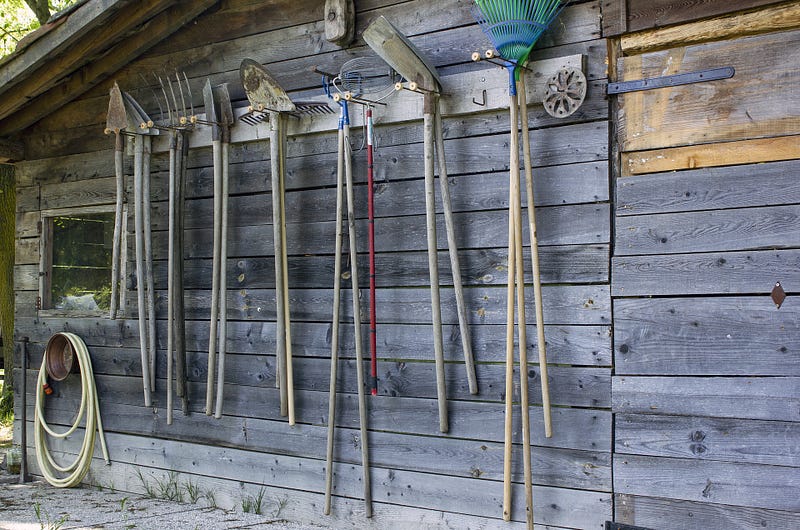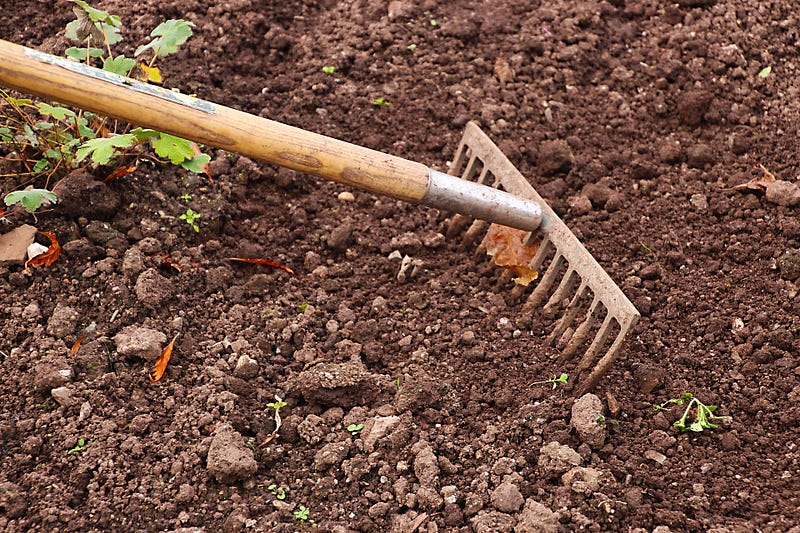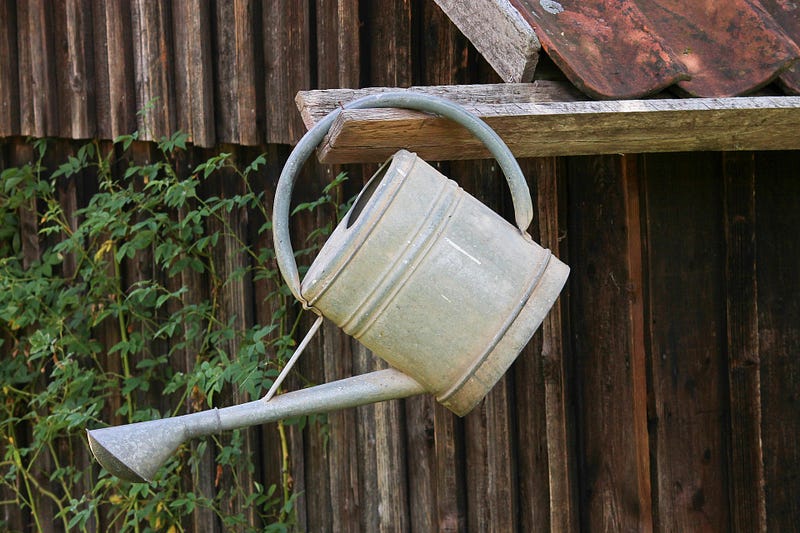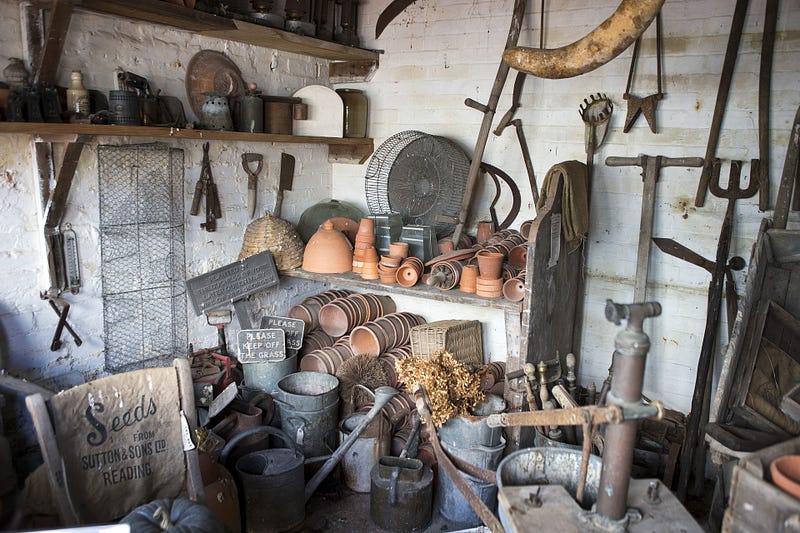You need to have the right tool for the job. So what tools are needed for a permaculture garden?
By Marit Parker

Having the right tool for the job you need to do makes the job easier and means you are less likely to injure yourself.
Choose tools that suit your build, strength and energy levels.
For advice on gardening tools for gardeners with various disabilities, visit Thrive’s Carry on Gardening website.
Safety first
Seriously: do not use the wrong tool for the job!
As a general rule, don’t wear gloves when using tools. The tool can slip out of your hand and cause an injury.
Be aware of people and animals in your vicinity, and stop what you are doing if they are too close.
When you are working, try to keep your tools in one place when you’re not using them.
When you put a tool down, make sure it is lying/standing safely and is clearly visible. It’s a good idea to stick some bright coloured tape on the handles of tools that blend into the background.
Don’t leave tools where someone (including yourself) could trip over them, or prop tools up where they could fall on someone.
Looking after your tools
- Rub linseed oil into wooden handles.
- Keep metal clean and dry, and oil blades and moving parts.
- Sharpen blades regularly.
Sharp tools are easier to use and as a result safer. To do this you need sharpening stones. There are different grades and different shapes, and some are wet stones (lubricated with water) and some are oil stones (lubricated with oil). After sharpening, tools are oiled and can be kept wrapped in an oil cloth. It is well worthwhile learning how to sharpen tools in person from someone experienced.
Never test a blade’s sharpness by running your thumb along the blade!
Essential tools

Garden spade / digging spade
Even in a no-dig garden, there will be times when you need to dig a hole in the ground, for example when you are fencing, making or clearing a small pond or ditch, or planting a pot-grown tree or shrub or one with a root ball.
Make sure the handle is the right height for you. If possible, choose one with a wooden handle because these can be replaced if they break. A steel spade won’t rust but is more expensive.
Garden fork / digging fork
Forks are perfect for weeding areas that are thick with roots because you can shake the soil off the roots as you dig them up. Using a spade, you would lose much of the soil.

Since nearly cutting this slow worm in half with a spade, I have been finding a fork works well for many things where I used to use a spade. For example, tree planting. I plant bare-rooted trees using the slit method, and a T-shaped slit can be made almost as quickly by wriggling the fork side to side, giving burrowing creatures a chance to escape.
Trowel
Trowels are really handy for close work and for small jobs.
Mattock
This clever tool has been in use for thousands of years in many parts of the world. Looking like a cross between a spade and an axe, it is especially useful in hard and rocky soils. It can also be used to grub out tree stumps or to clear ditches.
Hoes

There are several types of hoe. Which one(s) you have depends on what you will be using them for.
For weeding, two popular types are the hula hoe and the arrow hoe.
Smaller versions of hoes are useful for close work or for high raised beds. An example is the Japanese triangle hand hoe.
The azada or grubbing hoe, which is similar to a mattock, is used all over the world to prepare the ground for cultivation. It’s also known as a powrah, mammoty tool or mammootty tool in India, a changkol or changkul in Asia, an enxada in Brazil, and a jembe hoe in Africa.
Oscillating, or Hula hoe for bed prep, very shallow top cultivating, incorporating seeds and compost.
Rake / dirt rake

A rake is used after digging to prepare a fine tilth for sowing seeds.
Pitchfork / compost fork

A pitchfork is useful for turning or moving compost and also for moving mulch material.
Pruning tools
Having a selection of good pruning tools is invaluable.
Loppers

Loppers can cut anything up to thumb thickness. These are the one tool where a plastic handle is worthwhile as it makes them lightweight. Find a pair that are well-balanced. Look after the blades by not using them on anything too thick. Sharpen them carefully and keep them oiled.
Secateurs / hand pruners

Secateurs are hand-held loppers, used for snipping smaller branches close to you. They can be carried in a deep pocket or tool belt. Look after them the same way as loppers.
Pruning saw

A pruning saw is a clever design because it cuts as you draw the saw towards you, not when you push it away. This means it is ideal for using to cut branches above shoulder-height. A good pruning saw cuts quickly through small branches. Most pruning saws fold in on themselves for safe carrying. Make sure the catch clicks when you open the saw so it can’t close while you are using it.
A pruning saw on a long, extendable handle makes it possible to prune small branches above head height without climbing into the tree. Some also have loppers operated by a long cord.
Bowsaw
A small, lightweight bowsaw is really useful for sawing slightly bigger branches, and for sawing all cut wood into logs.
Billhook

A billhook is a tool designed specifically for cutting woody material. It is used in France and Italy to prune grape vines. In Britain, it is used by hedge-layers, thatchers, hurdle-makers and coppicers. Regional designs vary from heavyweight, double-sided billhooks to simpler, lighter-weight ones. All have a curved blade that can hook around a stem, enabling you to slice small branches accurately.
Machete / cutlass
A machete is larger than a billhook and may be curved, straight or have a slight hook. It is predominantly used to cut back bush in tropical and sub-tropical rainforests, although it’s also a great tool for cutting back brambles!
Sickle

Unlike a billhook or machete, a sickle is designed to cut grass, not woody material. It’s round shape and short handle means it is used for working close to you.
Scythe

A scythe has similar uses to a sickle but it’s long handle and straighter blade means it is used where there is more space. An experienced scyther can work as fast as someone with a strimmer or brush-cutter, and there are several advantages to using a scythe. As well as not using fossil fuels and not being noisy, the cut grass can be used to make hay.
Traditionally, the wood for the handle was grown in the bent shape, so making a new scythe was a long-term investment! Nowadays, the lightweight Austrian design has become popular and has helped revive interest in scything, with workshops, community scything days and annual competitions happening in a growing number of places.
Wheelbarrow

There are many different types of wheelbarrow, all designed for different uses. Find one that suits your build and what you’ll be using it for.
Buckets and trugs
Recycle!
For example mushroom trays and boxes that have had vegetables in from market stalls or shops can be used to hold pots of seedlings or to carry tools or gather weeds in.
Watering can and hose

Ideally a well-designed garden will water itself but there will be times you need to provide additional water.
Tarps and builders bags
Tarpaulins and builders dumpy bags can be really useful. Tarps can be laid on the ground to gather things and laid over things to keep them dry. Builders dumpy bags can be used to collect and drag mulch material, bedding material and hay.

Other useful things
Camera
Notebook
Weed ID books/websites
Measuring and mapping tools
Seed saving and storage equipment
List of local experts to call if you get stuck (eg arborist, earthworkers, seed savers)
This list focuses on garden tools, but other types of tools and equipment you may need include:
Food processing and preserving equipment
Advanced pruning and tree care equipment
Carpentry and other specialty tools, depending on your skillset.
Heavier equipment for larger sites
This list of tools and collection of images has been put together by Heather Jo Flores and Marit Parker.
Heather Jo Flores is the founder and Director of the Permaculture Women’s Guild. She is also a writer, artist, farmer and musician.
Marit is a farmer, gardener and writer and is one of the teachers on the Women’s Permaculture Guild online Permaculture Design Course.



